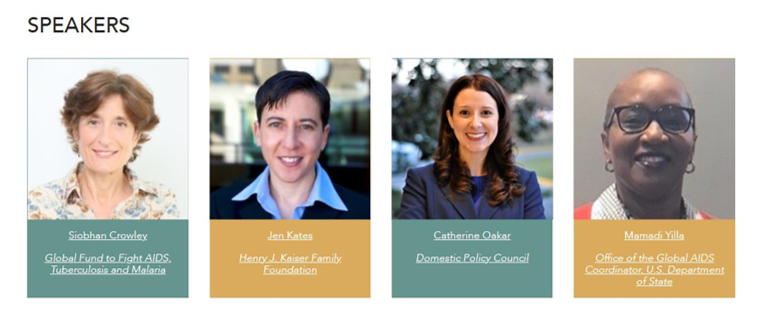THE LATEST INTEL: THE FUTURE OF U.S. AND GLOBAL HIV POLICY & FUNDING
When a new U.S. administration enters the White House, HIV-Informed funders are understandably eager to get a clear idea of what the country’s policy and budget priorities will be for the next four years. This is especially true in 2021—a time when the COVID-19 pandemic has significantly changed the global health landscape and new U.S. leadership has a very different view of the country’s role on domestic and international HIV issues.
Our latest webinar—the third and final in our Spring Funder Forum series—explored the future goals and priorities of not only the Biden administration, but also the Global Fund to Fight AIDS, Tuberculosis and Malaria. The following re-cap provides some of the key takeaways, which we hope can be used as guidance for any organization seeking to understand how the political stage will be set in the coming years.

Takeaway #1: Domestically, the Biden administration will address the HIV epidemic using a “whole of government” approach.
During his campaign, President Biden said he was committed to ending the HIV epidemic. To do that, his administration intends to use a “whole of government approach,” said Catherine Oakar, Special Assistant to the President for Public Health and Disparities for the White House Domestic Policy Council. That will mean looking at the big picture across not only health policy but other areas, such as food security, climate, transportation, and especially equity.
Additionally, the administration intends to build on the National HIV/AIDS Strategy, first launched during the Obama administration, and the Ending the HIV Epidemic initiative, which is focused on rapid diagnosis, treatment, and prevention using tools like PrEP and syringe exchange programs.
The Biden administration’s $670 million budget request to fight HIV—a $267 million increase from 2021—is “an illustration of the president’s commitment to end the epidemic,” said Oakar.
[Editor’s note: shortly after the webinar, Harold Phillips was named as the new Director of the White House Office of National AIDS Policy.]
Takeaway #2: Lessons from the COVID-19 pandemic could affect how the U.S. healthcare system treats those with HIV/AIDS.
The U.S. domestic response to the COVID-19 pandemic will inform how policymakers approach healthcare going forward, likely improving outcomes for those affected by HIV. The Biden administration is currently looking at ways to:
- Keep flexible healthcare options, like telehealth, in place after the pandemic
- Work with Congress and states to bolster providers’ ability to continue to deliver telehealth post-pandemic in a way that improves access and equity
- Help more people get coverage in the federal Health Insurance Marketplace
- Ensure people with HIV can receive affordable health insurance coverage
- Bolster non-discrimination protections from the Affordable Care Act
- Improve social supports for people living with HIV
- Lower the cost of prescription drugs
- Improve healthcare data collection
- Make long-term investments in public health infrastructure
Takeaway #3: U.S. funding for the COVID-19 response is indirectly helping funders in the HIV fight.
An influx of resources to address the pandemic has enabled many funders to help those affected by HIV, both domestically and abroad. For example, COVID-19 funds have been used to spur telehealth expansion and the adoption of rapid HIV self- and mail-in tests. “We’ve seen some policy things we’ve been hoping and praying for … suddenly just be possible overnight,” said Siobhan Crowley, Head of HIV at The Global Fund, which received $3.5 billion to fight COVID-19 through the American Rescue Plan Act.
“Providing personal protective equipment (PPE) and other resources to the healthcare workforce also improved delivery of HIV prevention and treatment services during COVID-19,” said Mamadi Yilla, Deputy Coordinator of Multisector Relations at the State Department’s Office of the U.S. Global AIDS Coordinator. “We were very grateful to receive $250 million and to have those resources to deploy,” said Yilla, referring to funds given to PEPFAR as part of the American Rescue Plan Act. “Getting those COVID-19-directed resources has been almost like a lifeline.”
Takeaway #4: As the world focuses on COVID-19 and pandemic preparedness, we can’t abandon commitments to end HIV/AIDS.
While pandemic preparedness and global health security should be top priorities, speakers stressed that efforts to fight HIV must not be sidelined. As we know, the pandemic has served to raise barriers to health and wellness even higher for populations living with, or at highest risk of acquiring HIV. With HIV funding already stagnating and the likelihood of missing the 2030 deadline for ending the epidemic as a public health threat, we had little room to backslide even prior to COVID-19. Webinar panelists reinforced the need to now bring a renewed sense of urgency and focus to the fight against HIV/AIDS.
The Bottom Line
At a time when COVID-19 is hindering the global HIV response and deepening inequality and health disparities in the U.S. and around the world, the Biden administration and Congressional leaders have stepped up to provide critical funding to address some of the systemic and structural issues that fuel both COVID-19 and HIV. However, it is yet to be seen whether the administration will ensure that these funds and the plans they support meaningfully address the needs of marginalized communities around the world – a critical issue for private funders to monitor and mobilize resources for.